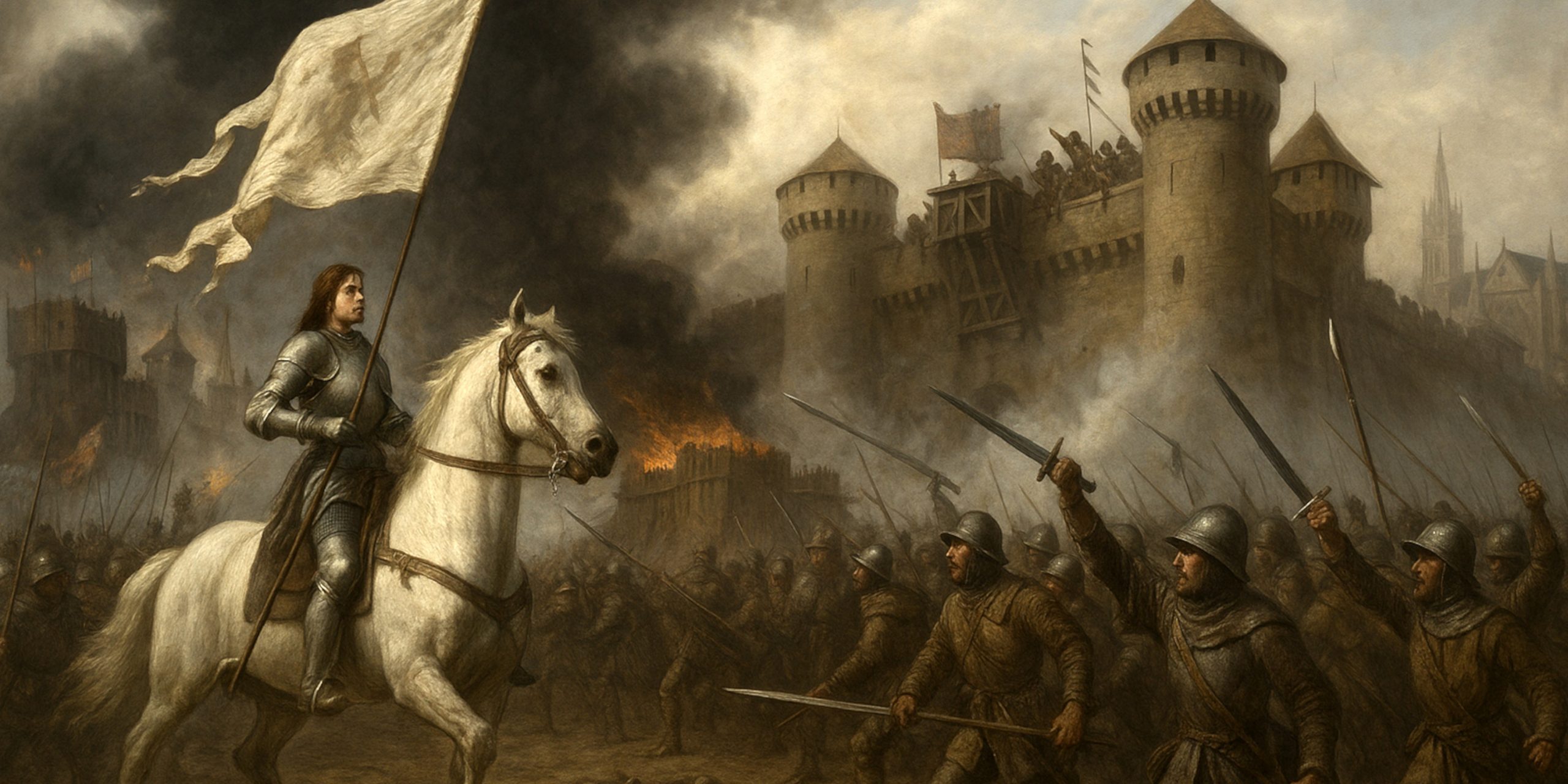
The Siege of Orléans was the turning point of the Hundred Years’ War, marking the first major French victory after years of defeats. English forces, supported by Burgundian allies, attempted to capture the city of Orléans in October 1428. The campaign was broken in May 1429, largely through the intervention of Joan of Arc, whose presence galvanised French resistance and changed the course of the war.
Background
By the late 1420s the English controlled much of northern France after victories at Agincourt and Verneuil. Orléans was strategically vital as it controlled access across the Loire River. Its capture would have opened the way for the English to advance deeper into central France and secure the conquest of the kingdom.
The French crown, weakened by civil war between Armagnac and Burgundian factions, relied on Orléans as a bastion of resistance. The siege therefore became not only a military struggle but also a symbol of survival for Charles VII and his supporters.
Forces
Commanders
| Side | Commander(s) |
|---|---|
| Kingdom of England | Thomas de Montacute, Earl of Salisbury; William de la Pole, Earl of Suffolk; John Talbot, Earl of Shrewsbury; Thomas Scales |
| Kingdom of France | Jean d’Orléans, Bastard of Orléans; Jean de Dunois; La Hire; Étienne de Vignolles (La Hire); Joan of Arc (from April 1429) |
Troop Composition
- English
- 3,500–5,000 men at the outset
- Predominantly longbowmen and men-at-arms
- Supported by Burgundian auxiliaries
- Siege engineers and artillery detachments
- French
- 4,000–6,000 defenders inside Orléans
- Reinforced by relief forces from Charles VII
- Mixed composition: men-at-arms, crossbowmen, militia, artillery crews
- Joan of Arc arrived with a relief army of c. 3,000
Arms and Armour
- English
- Longswords were carried by men-at-arms, often with cruciform hilts and straight double-edged blades suited to both cutting and thrusting.
- Falchions provided a heavier chopping weapon, popular among infantry and archers for close combat.
- Baselard daggers and bollock daggers served as secondary arms for finishing blows.
- Longbows formed the backbone of English firepower, supported by polearms such as bills and glaives.
- Armour consisted of plate harness over mail, with sallets and bascinets featuring visors for protection.
- Siege engines included bombards and smaller ribauldequins for suppressing defenders.
- French
- Arming swords (shorter knightly swords) were widely carried by men-at-arms, often optimised for thrusts against gaps in armour.
- Estocs (long, stiff thrusting swords without cutting edges) appeared among elite fighters, useful in close fighting against armoured foes.
- Messers and short hangers were common among militia and crossbowmen.
- Crossbows were prominent, supplemented by early hand-gonnes and wall-mounted artillery.
- Defensive equipment included brigandines and mail for the urban militia, with knights equipped in full plate.
- City defences mounted culverins and stone-throwing bombards to counter English siege towers and bastions.
Timeline of the Siege
- 12 October 1428: English forces begin the siege under the Earl of Salisbury.
- 27 October 1428: Salisbury mortally wounded by cannon fire while surveying the city. William de la Pole assumes command.
- December 1428 – February 1429: English construct a series of fortified bastions (boulevards) to blockade the city. Harsh winter slows operations.
- 12 February 1429: Battle of the Herrings. English convoy defeats a French relief force near Rouvray, strengthening English control.
- 29 April 1429: Joan of Arc enters Orléans with a relief column, boosting morale.
- 4–7 May 1429: French forces, inspired by Joan, launch attacks on English bastions. Strongholds including Saint Loup and the Tourelles are captured.
- 8 May 1429: English lift the siege and withdraw, marking a decisive French victory.
Archaeology
Excavations in Orléans and surrounding areas have revealed remnants of earthworks and siege fortifications, particularly near the site of the Tourelles bridge fortress. Cannonballs, arrowheads, and fragments of armour have been recovered, providing insight into both the scale of artillery bombardment and the intensity of hand-to-hand fighting during assaults. The city’s medieval walls, though rebuilt in parts, still preserve traces of the defences contested in 1429.
Contemporary Quotes
- Jean de Dunois, recounting Joan’s arrival: “She seemed a thing divine, sent by God, and all the soldiers took heart again.”
- An English chronicler on the lifting of the siege: “So great was the shame, that men spake of witchcraft and of sorcery as the cause of our undoing.”
- Joan of Arc to Charles VII: “Gentle Dauphin, the siege is raised. The Lord has given you back your city.”
Legacy
The lifting of the Siege of Orléans marked the beginning of the French resurgence in the Hundred Years’ War. Joan of Arc’s role became legendary, both as a figure of faith and as a symbol of national unity. Within months, French forces achieved further victories at Patay and advanced to Reims, where Charles VII was crowned.
The siege demonstrated the continuing power of fortified cities and the importance of morale in late medieval warfare. It also showed how artillery, though increasingly decisive, could not by itself guarantee success when met by determined defence and inspired leadership.
Watch the documentary:



